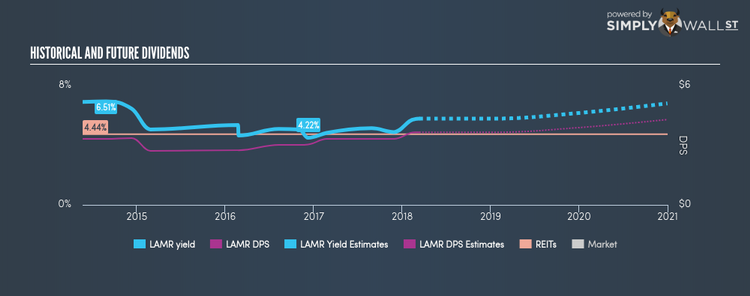Only 3 Days Left Before Lamar Advertising Company (REIT) (NASDAQ:LAMR) Will Start Trading Ex-Dividend, Should You Buy?

On the 29 March 2018, Lamar Advertising Company (REIT) (NASDAQ:LAMR) will be paying shareholders an upcoming dividend amount of $0.91 per share. However, investors must have bought the company’s stock before 16 March 2018 in order to qualify for the payment. That means you have only 3 days left! Is this future income a persuasive enough catalyst for investors to think about Lamar Advertising Company (REIT) as an investment today? Below, I’m going to look at the latest data and analyze the stock and its dividend property in further detail. See our latest analysis for Lamar Advertising Company (REIT)
5 questions to ask before buying a dividend stock
Whenever I am looking at a potential dividend stock investment, I always check these five metrics:
Is their annual yield among the top 25% of dividend payers?
Does it consistently pay out dividends without missing a payment of significantly cutting payout?
Has dividend per share amount increased over the past?
Is is able to pay the current rate of dividends from its earnings?
Will it be able to continue to payout at the current rate in the future?
How does Lamar Advertising Company (REIT) fare?
REITs are a special-case dividend payer. This is because a high percentage of their earnings are required to be paid out as dividends. The current trailing twelve-month payout ratio for LAMR is 102.46%, meaning that a portion of dividend payments are funded by retained earnings. Going forward, analysts expect LAMR’s payout to increase to 116.37% of its earnings, which leads to a dividend yield of around 5.79%. However, EPS is forecasted to fall to $3.16 in the upcoming year. Therefore, although payout is expected to increase, the fall in earnings may not equate to higher dividend income. Reliablity is an important factor for dividend stocks, particularly for income investors who want a strong track record of payment and a positive outlook for future payout. The reality is that it is too early to consider Lamar Advertising Company (REIT) as a dividend investment. It has only been consistently paying dividends for 4 years, however, standard practice for reliable payers is to look for a 10-year minimum track record. Compared to its peers, Lamar Advertising Company (REIT) produces a yield of 5.43%, which is high for REITs stocks.
Next Steps:
Now you know to keep in mind the reason why investors should be careful investing in Lamar Advertising Company (REIT) for the dividend. On the other hand, if you are not strictly just a dividend investor, the stock could still be offering some interesting investment opportunities. Given that this is purely a dividend analysis, you should always research extensively before deciding whether or not a stock is an appropriate investment for you. I always recommend analysing the company’s fundamentals and underlying business before making an investment decision. I’ve put together three relevant aspects you should further research:
Future Outlook: What are well-informed industry analysts predicting for LAMR’s future growth? Take a look at our free research report of analyst consensus for LAMR’s outlook.
Valuation: What is LAMR worth today? Even if the stock is a cash cow, it’s not worth an infinite price. The intrinsic value infographic in our free research report helps visualize whether LAMR is currently mispriced by the market.
Dividend Rockstars: Are there better dividend payers with stronger fundamentals out there? Check out our free list of these great stocks here.
To help readers see pass the short term volatility of the financial market, we aim to bring you a long-term focused research analysis purely driven by fundamental data. Note that our analysis does not factor in the latest price sensitive company announcements.
The author is an independent contributor and at the time of publication had no position in the stocks mentioned.

